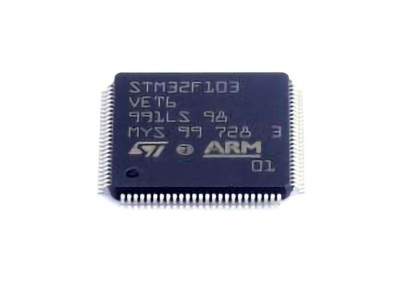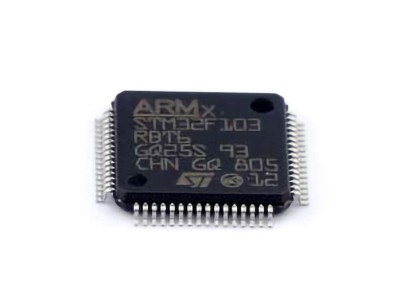
Introduction: The STM32F103VET6 – A Popular Choice for Embedded Systems
The ST STM32F103 VET6 microcontroller, part of the STM32F1 series, has become one of the most widely used choices for embedded systems developers. Its combination of a 32-bit ARM Cortex-M3 core, ample GPIO pins, and a variety of integrated peripherals make it an ideal solution for both simple and complex applications. However,despite its Power and versatility, developers can still run into problems that hinder progress in their projects. This guide will explore some of the most common issues users encounter with the STM32F103VET6 and offer practical solutions to get your projects back on track.
1. Power Supply Issues: Ensuring Proper Voltage Levels
One of the most frequent problems developers face when working with the STM32F103VET6 is inadequate power supply. The microcontroller requires a stable 3.3V voltage supply to operate correctly. Here are some steps to troubleshoot power-related issues:
Symptoms of Power Supply Problems:
The microcontroller does not power up.
Erratic behavior or freezing during operation.
The microcontroller does not respond to programming or debugging tools.
Solutions:
Check the Power Source: Ensure that the power source is stable and delivering a consistent 3.3V. If you’re using a voltage regulator, check the output with a multimeter to confirm the voltage is within the required range.
Examine Ground Connections: A poor ground connection can cause the microcontroller to malfunction. Verify that the ground of the STM32F103VET6 is properly connected to the ground of the power source.
Current Consumption: If you are driving peripherals or other components with the STM32F103VET6, make sure the power supply can handle the total current consumption. If the current draw is too high, it could cause voltage sag or instability.
2. Incorrect Clock Configuration: Ensuring Proper System Clock Setup
The STM32F103VET6 has multiple clock sources, including an external crystal oscillator and an internal phase-locked loop (PLL). Incorrect clock configuration can lead to timing errors, causing your application to behave unpredictably.
Symptoms of Clock Configuration Problems:
The system runs too fast or too slow.
Interrupts or Communication protocols (like UART or SPI) malfunction.
The microcontroller behaves inconsistently.
Solutions:
Check the Clock Source: Ensure that the clock source (external crystal or internal oscillator) is set up correctly. If using an external crystal, ensure it is the correct frequency and properly connected to the microcontroller.
Review the PLL Configuration: Verify the PLL settings in the microcontroller’s configuration. The STM32F103VET6 allows you to adjust the PLL to achieve different clock speeds. Ensure that the settings are suitable for your application.
Use the STM32CubeMX Tool: The STM32CubeMX tool allows you to configure the clock settings visually. It generates the correct initialization code for your project, helping avoid common mistakes.
3. Bootloader and Firmware Issues: Flashing and Debugging Problems
A common problem with the STM32F103VET6 is difficulty flashing new firmware or connecting to the microcontroller’s bootloader. This is typically related to either hardware setup or incorrect bootloader settings.
Symptoms of Bootloader and Firmware Issues:
The microcontroller does not respond to the programming interface .
The device is not detected in the STM32 programming tools.
Firmware fails to upload or runs with errors.
Solutions:
Verify Boot Mode: The STM32F103VET6 has several boot modes (main flash, system memory bootloader, and external memory). Make sure that the BOOT0 pin is correctly configured. If it is set high, the microcontroller will attempt to boot from the system memory (bootloader) instead of the main flash.
Check USB/Serial Connections: If using a USB-to-serial adapter or ST-Link for programming, ensure the connection is secure. Loose or faulty connections can prevent the programming tool from detecting the microcontroller.
Use ST-Link/V2 or JTAG Debugger: If you’re unable to program the STM32F103VET6, consider using an ST-Link/V2 debugger to directly interface with the microcontroller for both debugging and flashing firmware.
Reset the Microcontroller: If the STM32F103VET6 is stuck in a bad state, reset the device by toggling the NRST pin or using a reset button. This can sometimes clear bootloader-related problems.
4. Connectivity Problems: UART, SPI, and I2C Communication Issues
The STM32F103VET6 offers several communication interfaces, including UART, SPI, and I2C. However, when these interfaces are not set up correctly, communication problems can arise.
Symptoms of Communication Problems:
Data is corrupted or lost during transmission.
Devices connected via UART, SPI, or I2C do not respond.
The microcontroller seems to freeze or experience timeouts during communication.
Solutions:
Check the Wiring and Connections: Ensure all connections are properly wired. For UART, check TX/RX pins; for SPI, verify MOSI, MISO, SCK, and CS connections; for I2C, ensure SDA and SCL are connected correctly.
Configure Peripherals Correctly: Ensure that the STM32F103VET6’s communication peripherals (like USART, SPI, or I2C) are configured correctly in your firmware. The baud rate, data bits, parity, and stop bits for UART, for example, need to match the remote device.
Use Logic Analyzers or Oscilloscopes: If you suspect a communication issue, use a logic analyzer or oscilloscope to monitor the signals and identify if the data is transmitted correctly.
5. Debugging Challenges: Efficient Debugging Techniques
Debugging embedded systems can be tricky, especially when working with microcontrollers like the STM32F103VET6. However, with the right approach, you can efficiently identify and fix issues in your code or hardware setup.
Symptoms of Debugging Challenges:
The microcontroller does not respond to breakpoints or debugging commands.
It’s difficult to identify where in the code the error occurs.
The microcontroller crashes or behaves unexpectedly during debugging sessions.
Solutions:
Use Hardware Debugging Tools: Utilize debugging tools such as ST-Link/V2 or a JTAG debugger to perform step-by-step debugging. These tools provide real-time insight into the microcontroller’s registers, memory, and code execution flow.
Enable Debugging Features in STM32CubeMX: STM32CubeMX can configure debugging options like SWD (Serial Wire Debug) for more efficient debugging. It’s also a great tool for generating initialization code that includes debugging support.
Use Software Watchdogs: Software watchdog timers can help reset the microcontroller in case of a crash, which is useful when debugging complex applications. Watchdog timers can be configured to automatically reset the system if it becomes unresponsive.
Debugging with Serial Output: If you’re unable to use a debugger, consider using the UART to send debug information. Serial print statements can give you visibility into the execution flow and the state of your system at key points.
6. Peripheral Interfacing Issues: Getting External Components to Work
The STM32F103VET6 offers a broad range of peripheral options, including GPIO, ADC, timers, and DAC. However, connecting and configuring these peripherals properly is crucial for your system’s success.
Symptoms of Peripheral Interfacing Problems:
The peripherals do not function as expected.
The system does not detect the connected sensor or actuator.
Timers or analog-to-digital converters (ADCs) don’t provide correct readings.
Solutions:
Configure Peripherals in STM32CubeMX: Use STM32CubeMX to set up and configure the peripherals. CubeMX generates initialization code, ensuring that you don’t miss critical setup steps.
Check Pin Mapping: Ensure that the pins for each peripheral are correctly mapped and configured as inputs or outputs. GPIO pin configuration errors are common in peripheral interfacing issues.
Use External Power for High-Current Components: If you’re interfacing with components like motors or high-power LED s, ensure that they have their own power supply. Don’t rely on the STM32F103VET6 to supply power to high-current devices.
Verify the Peripheral Connections: Whether you’re working with an analog sensor, digital input, or communication interface, verify the wiring and electrical connections.
7. Software Issues: Firmware Bugs and Code Optimization
Sometimes, the problem might not be hardware-related but rather a bug or inefficiency in the firmware. Software bugs can manifest in unpredictable behavior, so ensuring clean and efficient code is essential.
Symptoms of Software Bugs:
The system behaves erratically or crashes without clear cause.
Unexpected delays or incorrect outputs in the system.
Functions or routines fail to execute as expected.
Solutions:
Use Unit Testing: Develop unit tests for key components of your code. This ensures that each function or module behaves correctly in isolation before integration.
Optimize Code for Performance: Poorly optimized code can lead to performance issues. Review your code for areas of improvement, such as memory usage, timing, and interrupt handling.
Review Interrupt Priorities: Incorrect interrupt priority settings can lead to system crashes or missed events. Make sure your interrupt priorities are correctly set to avoid conflicts.
Conclusion: Keep Troubleshooting and Stay Efficient
The STM32F103VET6 is a powerful and flexible microcontroller, but like any embedded system, it comes with its own set of challenges. By understanding common issues like power supply problems, clock configuration, programming errors, and peripheral interfacing issues, you can troubleshoot effectively and keep your project moving forward. With patience and a systematic approach, you’ll be able to resolve most issues and continue to build successful systems using the STM32F103VET6. Happy debugging!
If you’re looking for models of commonly used electronic components or more information about STM32F103VET6 datasheets, compile all your procurement and CAD information in one place.
( Partnering with an electronic component supplier) sets your team up for success, ensuring that the design, production and procurement processes are streamlined and error-free. (Contact us) for free today.


